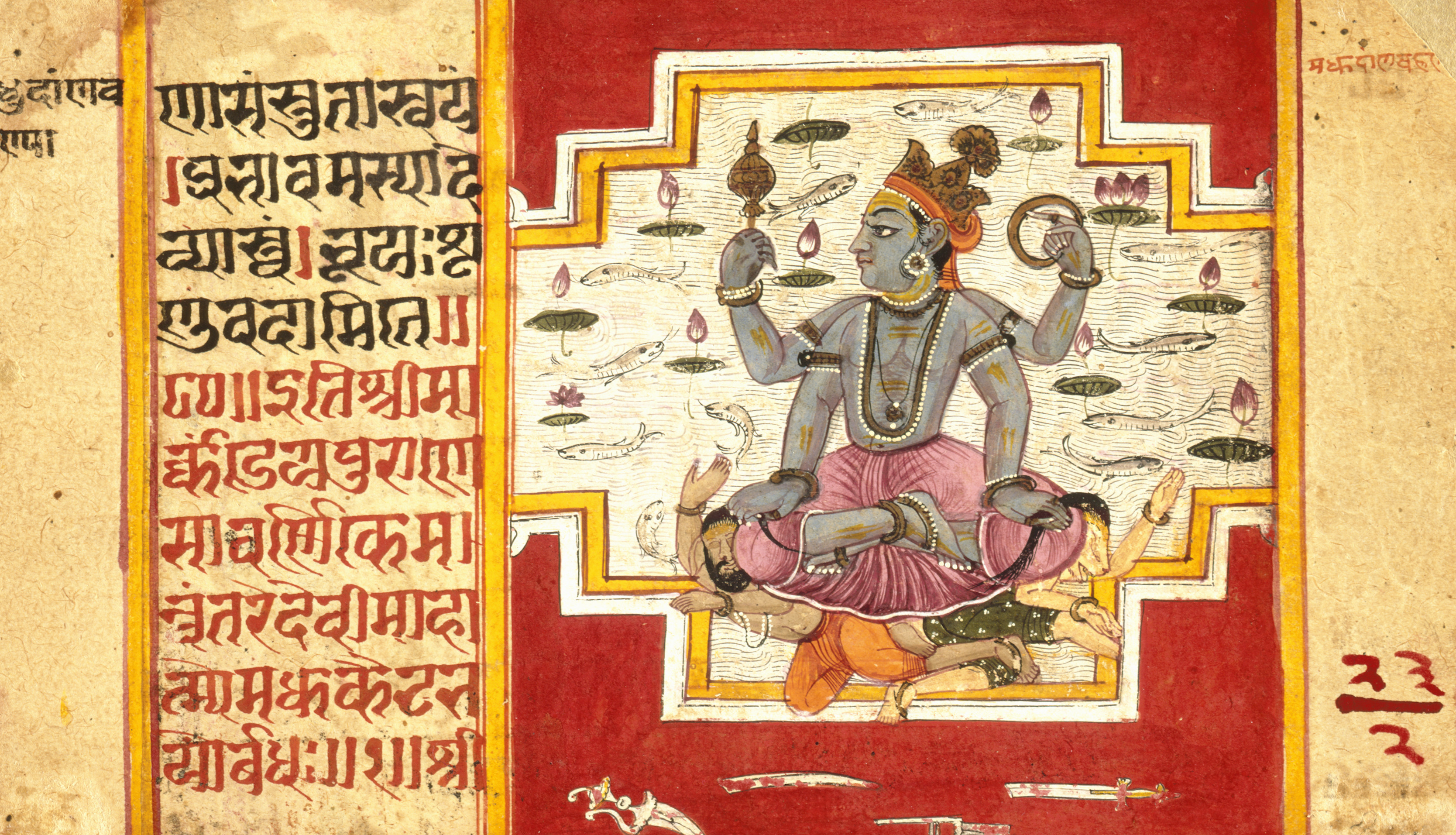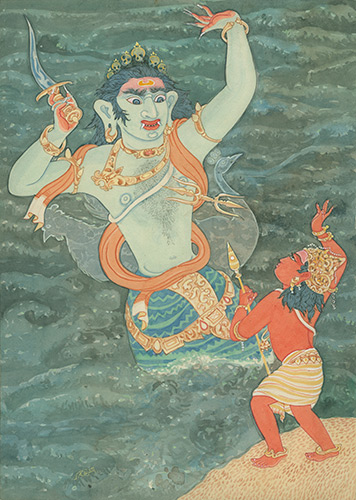|
Ganesha
Ganesha or Ganesh (, , ), also known as Ganapati, Vinayaka and Pillaiyar, is one of the best-known and most worshipped Deva (Hinduism), deities in the Hindu deities, Hindu pantheon and is the Supreme God in the Ganapatya sect. His depictions are found throughout India. Hindu denominations worship him regardless of affiliations. Devotion to Ganesha is widely diffused and extends Ganesha in world religions, to Jains and Buddhists and beyond India. Although Ganesha has many attributes, he is readily identified by his Asiatic Elephant, elephant head and four arms. He is widely revered, more specifically, as the remover of obstacles and bringer of good luck; the patron of The arts, arts and Science, sciences; and the Deva (Hinduism), deva of intellect and wisdom. As the god of beginnings, he is honoured at the start of rites and ceremonies. Ganesha is also invoked during writing sessions as a patron of letters and learning., Vigna means obstacles Nasha means destroy. These ideas ar ... [...More Info...] [...Related Items...] OR: [Wikipedia] [Google] [Baidu] [Amazon] |
Consorts Of Ganesha
The marital status of the Hindu deity Ganesha varies widely in mythological stories and the issue has been the subject of considerable scholarly review. Several patterns of associations with different consorts are identifiable. One pattern of myths identifies Ganesha as an unmarried '' brahmacārin'' with no consorts. Another mainstream pattern associates him with the concepts of Buddhi (intellect), Siddhi (spiritual power), and ''Riddhi'' (prosperity); these qualities are sometimes personified as goddesses who are considered to be Ganesha's wives. Another pattern connects Ganesha with the goddess of culture and the arts, Sarasvati. In the Bengal region he is linked with the banana tree, Kala Bo (or Kola Bou). Usually Ganesha's consort is portrayed as his shakti, a personification of his creative energy. Some of the differences between these patterns can be understood by looking at regional variations across India, the time periods in which the patterns are found, and the traditi ... [...More Info...] [...Related Items...] OR: [Wikipedia] [Google] [Baidu] [Amazon] |
Ganesha Purana
The Ganesha Purana (Sanskrit:; ) is a Sanskrit text that deals with the Hindu deity Ganesha (). It is an (minor Purana) that includes mythology, cosmogony, genealogy, metaphors, yoga, theology and philosophy relating to Ganesha. The text is organized in two voluminous sections, one on mythology and genealogy (''Krida-khanda'', 155 chapters), and the other on theology and devotion (''Upasana-khanda'', 92 chapters). It exists in many versions. The text's composition and expansion date has been estimated to be the late medieval period, between the 13th- to 18th-century CE, during a period of political turmoil during the Islamic rule period of South Asia. The text shares the features and stories found in all major Puranas, and like all Puranas, it is, states Bailey, also a cultural object and reflects the cultural needs and mores, in the environment it was written. The Ganesha Purana, along with the Mudgala Purana, Brahma Purana and Brahmanda Purana, is one of four Puranic gen ... [...More Info...] [...Related Items...] OR: [Wikipedia] [Google] [Baidu] [Amazon] |
Ganesh Chaturthi
Ganesh Chaturthi (ISO: ), also known as Vinayaka Chaturthi () or Vinayaka Chavithi () or Vinayagar Chaturthi (), is a Hindu festival celebrating the birthday of Hindu deity Ganesh. The festival is marked with the installation of Ganesha's ''murtis'' (devotional representations of a deity) privately in homes and publicly on elaborate pandals (temporary stages). Observances include chanting of Vedic hymns and Hindu texts, such as prayers and ''vrata'' (fasting). Offerings and '' prasada'' from the daily prayers, that are distributed from the pandal to the community, include sweets such as '' modak'' as it is believed to be a favourite of Ganesha. The festival ends on the tenth day after start, when the ''murti'' is carried in a public procession with music and group chanting, then immersed in a nearby body of water such as a river or sea, called ''visarjana'' on the day of Ananta Chaturdashi. In Mumbai alone, around 150,000 murtis are immersed annually. ... [...More Info...] [...Related Items...] OR: [Wikipedia] [Google] [Baidu] [Amazon] |
Ganapatya
Ganapatya is a denomination of Hinduism that worships Ganesha (also called Ganapati) as the Parabrahman, Saguna Brahman.Ganapatyas Article from PHILTAR, Division of Religion and Philosophy, St Martin's College Beliefs The worship of is considered complementary with the worship of other deities. Hindus of all sects begin prayers, important undertakings, and religious ceremonies with an invocation of Ganesha, because of Ganesha's role as the god of beginnings. But although most Hindu sects do revere Ganesha, the Ganapatya sect goes further than that, and declares Ganesha to be the supreme being. Ganapatya is one of the five principal Hindu sects which focus on a particular deity, along ...[...More Info...] [...Related Items...] OR: [Wikipedia] [Google] [Baidu] [Amazon] |
Ganesh Jayanti
Ganesh Jayanti (literally "Ganesha's birthday", also known as Bhadra shukla chaturthi, Tilkund chaturthi, and Varad chaturthi, is a Hinduism, Hindu Hindu festival, festival. This occasion celebrates the birth day of Ganesha, the lord of wisdom. It is a popular festival particularly in the Indian state of Maharashtra and it is also celebrated in Goa held during the shukla paksha chaturthi day (fourth day of the bright fortnight or the waxing moon) in the month of Bhadra as per the Hindu calendar, which corresponds to the Gregorian calendar month of January/February. In 2022, Ganesh Jayanti falls on 4 February. The distinction between the Ganesh Jayanti and the more popular, almost pan-Indian Ganesh Chaturthi festival is that the latter festival is observed in the month of August/September (Bhadrapada Hindu month). According to one tradition, Ganesh Chaturthi is also considered as the birthday of Ganesha. This festival of Ganesha is also called as the Tilo Chauth or Sakat Chauthis ... [...More Info...] [...Related Items...] OR: [Wikipedia] [Google] [Baidu] [Amazon] |
Kangiten
Kangiten or Kankiten (, "god of bliss"; Sanskrit (IAST): ), also known as Binayaka (毘那夜迦; Skt. ), Ganabachi (誐那鉢底, alternatively Ganahachi or Ganahattei; Skt. ), or more commonly, Shōten or Shōden (聖天, lit. "sacred god" or "noble god"), is a Deva (Buddhism), deva (''ten'') venerated mainly in the Shingon Buddhism, Shingon and Tendai schools of Japanese Buddhism who is the Buddhist equivalent of the Hinduism, Hindu deity Ganesha. Although Kangiten (Shōten) and Ganesha share a common origin and a number of traits, there are also some marked differences between the two. For instance, the Buddhist Vinayaka was (at least at first) negatively portrayed as the creator of obstacles and the leader of a class of malignant demons who obstructed Buddhist practice called ''vinayakas'', though later tradition made an attempt to distinguish between the ''vinayakas'' and their lord, who became seen as a manifestation of the bodhisattva Avalokiteśvara, Avalokiteshvara (Gu ... [...More Info...] [...Related Items...] OR: [Wikipedia] [Google] [Baidu] [Amazon] |
Mudgala Purana
The Mudgala Purana (Sanskrit:; ) is a Hindu religious text dedicated to the Hindu deity Ganesha (). It is an that includes many stories and ritualistic elements relating to Ganesha. The Ganesha Purana and the Mudgala Purana are core scriptures for devotees of Ganesha, known as '' Ganapatyas'' (). These are the only two Purana that are exclusively dedicated to Ganesha. Content Like the Ganesha Purana, the Mudgala Purana considers Ganesha to represent the ultimate reality of being. As such, Ganesha's manifestations are endless but eight of his incarnations (Sanskrit:; ) are of most importance. The eight incarnations are introduced in MudP 1.17.24-28. The text is organized into sections for each of these incarnations. These are not the same as the four incarnations of Ganesha that are described in the Ganesha Purana. Eight incarnations of Ganesha The incarnation described in the Mudgala Purana took place in different cosmic ages. The Mudgala Purana uses these incarnations ... [...More Info...] [...Related Items...] OR: [Wikipedia] [Google] [Baidu] [Amazon] |
Sankashti Chaturthi
Sankashti Chaturthi, also known as Sankatahara Chaturthi and Sankashti, is a holy day in every lunar month of the Hindu calendar dedicated to the Hindu god Ganesha. This day falls on the fourth day of the Krishna Paksha (the dark fortnight). If this Chaturthi falls on a Tuesday, it is called Angaraki Sankashti Chaturthi, Angaraki Chaturthi, Angaraki and Angarika. Angaraki Sankashti Chaturthi is considered highly sacred. This is said to have started around 700 BC as an obstacle removal ritual regarding conflicting views of confidence as stated by Abhisheka Maharishi in tutoring his pupil Aishwarya while deriving due reason from the scriptures. Practices Sankashti Chaturthi comes on every fourth day after Pournami full moon (Krishna Paksha) of the Hindu lunar calendar month. On Sankashti Chaturthi, devotees observe a strict fast. They break the fast at night after having darshan (auspicious sight) of the moon preceded by prayers to Ganesha. The Angaraki Chaturthi (angarak in ... [...More Info...] [...Related Items...] OR: [Wikipedia] [Google] [Baidu] [Amazon] |
Parvati
Parvati (, , IPA: /Sanskrit phonology, pɑɾʋət̪iː/), also known as Uma (, , IPA: Sanskrit phonology, /ʊmɑː/) and Gauri (, , IPA: /Sanskrit phonology, gə͡ʊɾiː/), is one of the principal goddesses in Hinduism, revered as the Devi, goddess of power, energy, nourishment, harmony, love, beauty, devotion, and motherhood. Along with Lakshmi and Saraswati, Sarasvati, she forms the trinity, known as the Tridevi. From her first appearance as a goddess during the Itihasa-Purana, epic period (400 BCE – 400 CE), Parvati is primarily depicted as the consort of the god Shiva. According to various Puranas, Parvati is the reincarnation of Sati (Hindu goddess), Sati, Shiva's first wife, who relinquished her body to sever familial ties with her father, Daksha, after he had insulted Shiva. Parvati is often equated with the other goddesses such as Sati, Uma, Kali and Durga and due to this close connection, they are often treated as one and the same, with their stories frequently ove ... [...More Info...] [...Related Items...] OR: [Wikipedia] [Google] [Baidu] [Amazon] |
Kartikeya
Kartikeya (/Sanskrit phonology, kɑɾt̪ɪkejə/; ), also known as Skanda (Sanskrit phonology, /skən̪d̪ə/), Subrahmanya (/Sanskrit phonology, sʊbɾəɦməɲjə/, /ɕʊ-/), Shanmukha (Sanskrit phonology, /ɕɑnmʊkʰə/) and Murugan (/Sanskrit phonology, mʊɾʊgən/), is the Hinduism, Hindu List of war deities, god of war. He is generally described as the son of the deities Shiva and Parvati and the brother of Ganesha. Kartikeya has been an important deity in the Indian subcontinent since Vedic period, ancient times. Mentions of Skanda in the Sanskrit literature data back to fifth century BCE and the mythology relating to Kartikeya became widespread in North India around the second century BCE. Archaeological evidence from the first century CE and earlier shows an association of his iconography with Agni, the Hindu god of fire, indicating that Kartikeya was a significant deity in early Hinduism. He is hailed as the "favoured god of the Tamils", and the tutelary dei ... [...More Info...] [...Related Items...] OR: [Wikipedia] [Google] [Baidu] [Amazon] |





